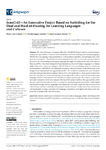Mostrar o rexistro simple do ítem
InnoDAT—An Innovative Project Based on Subtitling for the Deaf and Hard-of-Hearing for Learning Languages and Cultures
| dc.contributor.author | Couto-Cantero, Pilar | |
| dc.contributor.author | Fraga Castrillón, Noemi | |
| dc.contributor.author | Trovato, Giuseppe | |
| dc.date.accessioned | 2024-09-05T11:04:10Z | |
| dc.date.available | 2024-09-05T11:04:10Z | |
| dc.date.issued | 2023-10-16 | |
| dc.identifier.citation | Couto-Cantero, P.; Fraga-Castrillón, N.; Trovato, G. InnoDAT—An Innovative Project Based on Subtitling for the Deaf and Hard-of-Hearing for Learning Languages and Cultures. Languages 2023, 8, 235. https://doi.org/10.3390/languages8040235 | es_ES |
| dc.identifier.issn | 2226-471X | |
| dc.identifier.uri | http://hdl.handle.net/2183/38884 | |
| dc.description.abstract | [Abstract] The InnoDAT project is framed within the TRADILEX Project, which is aimed at demonstrating the applicability of Audiovisual Translation (AVT) for teaching and learning languages. TRADILEX is an ongoing project presented at a state-funded competitive call and supported by the Spanish Government. This article is aimed at presenting InnoDAT, an innovative project based in the use of AVT for teaching and learning languages through: Subtitling for the Deaf and Hard-of-Hearing (SDH). It has been designed to learn Spanish as a Second Foreign Language in an Italian Higher Education context according to a B2 CEFR level. The methodology used was developed by researchers of TRADILEX. Six tailormade Learning Units (LU), based on the SDH mode, were designed and implemented among participants (N = 97). Authentic materials and cultural matters were also used and adapted according to the B2 level. The results show a clear improvement in the process of teaching and learning languages, knowledge of the culture and traditions of the target language, and the consciousness of accessibility among the participants. The authors compare this innovative research with former research The InnoDAT project validates the applicability of the didactic audiovisual translation (DAT) as a means for learning languages and cultures within digital educational settings and how languages and cultures are intricately connected. Moreover, not only cultural issues but also accessibility were paramount in this research. Finally, motivation, autonomous and meaningful learning, communicative language competence, and digital competence were also nurtured by means of the InnoDAT project. | es_ES |
| dc.description.sponsorship | Ministerio de Ciencia e Innovación; PID2019-107362GA-I00 AEI/10.13039/501100011033. | es_ES |
| dc.language.iso | eng | es_ES |
| dc.publisher | MDPI AG | es_ES |
| dc.relation.uri | https://doi.org/10.3390/languages8040235 | es_ES |
| dc.rights | Atribución 3.0 España | es_ES |
| dc.rights | © 2023 by the authors. Licensee MDPI, Basel, Switzerland. This article is an open access article distributed under the terms and conditions of the Creative Commons Attribution (CC BY) license (https://creativecommons.org/licenses/by/4.0/). | es_ES |
| dc.rights.uri | http://creativecommons.org/licenses/by/3.0/es/ | * |
| dc.subject | didactic audiovisual translation (DAT) | es_ES |
| dc.subject | innovation | es_ES |
| dc.subject | language | es_ES |
| dc.subject | culture | es_ES |
| dc.subject | subtitling for the deaf and hard-of-hearing (SDH) | es_ES |
| dc.subject | Spanish as a foreign language | es_ES |
| dc.subject | accessibility | es_ES |
| dc.subject | digital and nondigital contexts | es_ES |
| dc.title | InnoDAT—An Innovative Project Based on Subtitling for the Deaf and Hard-of-Hearing for Learning Languages and Cultures | es_ES |
| dc.type | info:eu-repo/semantics/article | es_ES |
| dc.rights.access | info:eu-repo/semantics/openAccess | es_ES |
| UDC.journalTitle | Languages | es_ES |
| UDC.volume | 8 | es_ES |
| UDC.issue | 4 | es_ES |
| dc.identifier.doi | 10.3390/languages8040235 |
Ficheiros no ítem
Este ítem aparece na(s) seguinte(s) colección(s)
-
GI-DILEC - Artigos [29]






